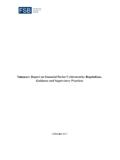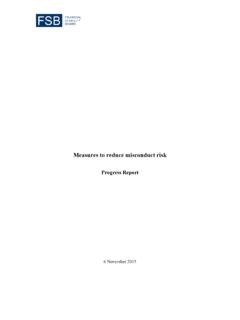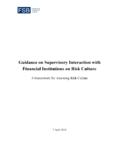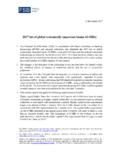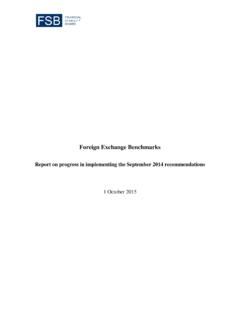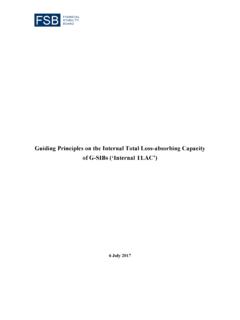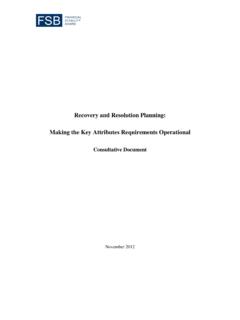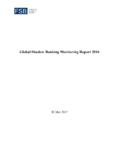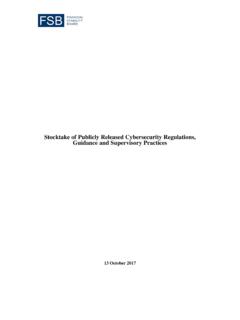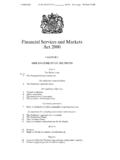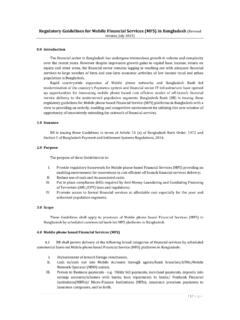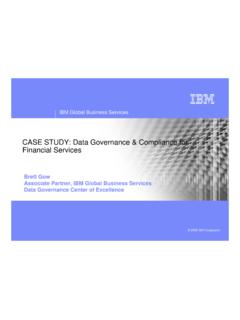Transcription of Artificial intelligence and machine learning in financial ...
1 Artificial intelligence and machine learning in financial services Market developments and financial stability implications 1 November 2017. The financial Stability Board (FSB) is established to coordinate at the international level the work of national financial authorities and international standard-setting bodies in order to develop and promote the implementation of effective regulatory, supervisory and other financial sector policies. Its mandate is set out in the FSB Charter, which governs the policymaking and related activities of the FSB. These activities, including any decisions reached in their context, shall not be binding or give rise to any legal rights or obligations under the FSB's Articles of Association. Contacting the financial Stability Board Sign up for e-mail alerts: Follow the FSB on Twitter: @FinStbBoard E-mail the FSB at: Copyright 2017 financial Stability Board.
2 Please refer to: Contents Page Executive Summary .. 1. Introduction .. 3. 1. Background and definitions .. 3. 2. Drivers .. 7. 3. Selected use cases .. 10. Customer-focused uses: credit scoring, insurance and client-facing chatbots .. 11. Credit scoring 12. Use for pricing, marketing and managing insurance policies .. 13. Client-facing chatbots .. 14. Operations-focused uses .. 15. Capital optimisation use case .. 15. Model risk management (back-testing and model validation) and stress testing .. 16. Market impact analysis (modelling of trading out of big positions) .. 17. Trading and portfolio management .. 18. AI and machine learning in trading execution .. 18. Scope for the use of AI and machine learning in portfolio management .. 18.
3 AI and machine learning in regulatory compliance and supervision .. 19. RegTech: applications by financial institutions for regulatory compliance .. 20. Uses for macroprudential surveillance and data quality assurance .. 21. SupTech: uses and potential uses by central banks and prudential authorities .. 21. Uses by market regulators for surveillance and fraud detection .. 23. 4. Micro- financial analysis .. 24. Possible effects of AI and machine learning on financial markets .. 24. Possible effects of AI and machine learning on financial institutions .. 25. Possible effects of AI and machine learning on consumers and investors .. 27. Current regulatory considerations regarding the use of AI and machine learning .. 28. 5. Macro- financial analysis.
4 29. Market concentration and systemic importance of institutions .. 29. Potential Market Vulnerabilities .. 30. Networks and interconnectedness .. 31. Other implications of AI and machine learning applications .. 31. 6. Conclusions and implications for financial stability .. 32. iii 35. Annex A: Legal issues around AI and machine learning .. 37. Annex B: AI ethics .. 39. Annex C: Drafting team members .. 40. iv Executive Summary Artificial intelligence (AI) and machine learning are being rapidly adopted for a range of applications in the financial services industry. As such, it is important to begin considering the financial stability implications of such uses. Because uses of this technology in finance are in a nascent and rapidly evolving phase, and data on usage are largely unavailable, any analysis must be necessarily preliminary, and developments in this area should be monitored closely.
5 Many applications , or use cases , of AI and machine learning already exist. The adoption of these use cases has been driven by both supply factors, such as technological advances and the availability of financial sector data and infrastructure, and by demand factors, such as profitability needs, competition with other firms, and the demands of financial regulation. Some of the current and potential use cases of AI and machine learning include: - financial institutions and vendors are using AI and machine learning methods to assess credit quality, to price and market insurance contracts, and to automate client interaction. - Institutions are optimising scarce capital with AI and machine learning techniques, as well as back-testing models and analysing the market impact of trading large positions.
6 - Hedge funds, broker-dealers, and other firms are using AI and machine learning to find signals for higher (and uncorrelated) returns and optimise trading execution. - Both public and private sector institutions may use these technologies for regulatory compliance, surveillance, data quality assessment, and fraud detection. With the FSB FinTech framework, 1 our analysis reveals a number of potential benefits and risks for financial stability that should be monitored as the technology is adopted in the coming years and as more data becomes available. In some cases, these observations are also contained in the FSB report on regulatory and supervisory issues around FinTech. 2 They are: - The more efficient processing of information, for example in credit decisions, financial markets, insurance contracts, and customer interaction, may contribute to a more efficient financial system.
7 The RegTech and SupTech applications of AI and machine learning can help improve regulatory compliance and increase supervisory effectiveness. - At the same time, network effects and scalability of new technologies may in the future give rise to third-party dependencies. This could in turn lead to the emergence of new systemically important players that could fall outside the regulatory perimeter. - applications of AI and machine learning could result in new and unexpected forms of interconnectedness between financial markets and institutions, for instance based on the use by various institutions of previously unrelated data sources. 1 FSB (2016), Fintech: Describing the Landscape and a Framework for Analysis, March [unpublished]. 2 FSB (2017), financial Stability Implications from FinTech, Supervisory and Regulatory Issues that Merit Authorities Attention, June.
8 1. - The lack of interpretability or auditability of AI and machine learning methods could become a macro-level risk. Similarly, a widespread use of opaque models may result in unintended consequences. - As with any new product or service, there are important issues around appropriate risk management and oversight. It will be important to assess uses of AI and machine learning in view of their risks, including adherence to relevant protocols on data privacy, conduct risks, and cybersecurity. Adequate testing and training' of tools with unbiased data and feedback mechanisms is important to ensure applications do what they are intended to do. Overall, AI and machine learning applications show substantial promise if their specific risks are properly managed.
9 The concluding section gives preliminary thoughts on governance and development of models, as well as auditability by institutions and supervisors. 2. Introduction This report analyses possible financial stability implications of the use of Artificial intelligence (AI) and machine learning in financial services . It was drafted by a team of experts from the FSB financial Innovation Network (FIN). The report draws on discussions with firms; 3. academic research; public and private sector reports; and ongoing work at FSB member The report analyses potential financial stability implications of the growing use of AI by financial institutions. Given the relative novelty of many applications , and the paucity of data on adoption, it is necessarily a horizon-scanning piece.
10 The report is structured as follows. In section 1, the key concepts of the report are defined, and some background is given on the development of AI and machine learning for financial applications . Section 2 describes supply and demand factors driving the adoption of these techniques in financial services . Section 3 describes four sets of use cases: (i) customer-focused applications ; (ii) operations-focused uses; (iii) trading and portfolio management; and (iv). regulatory compliance and supervision. Section 4 contains a micro-analysis of the effects of adoption on financial markets, institutions and consumers. Section 5 gives a macro-analysis of effects on the financial system. Finally, section 6 concludes with an assessment of implications for financial stability.
